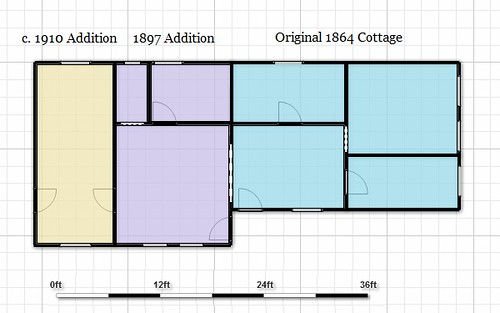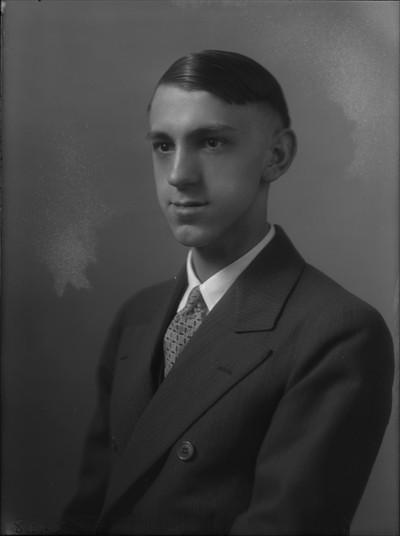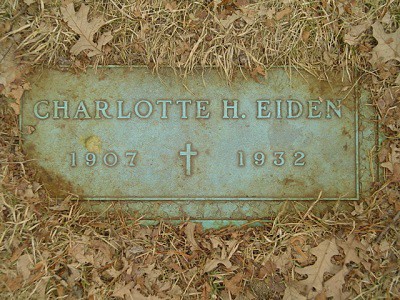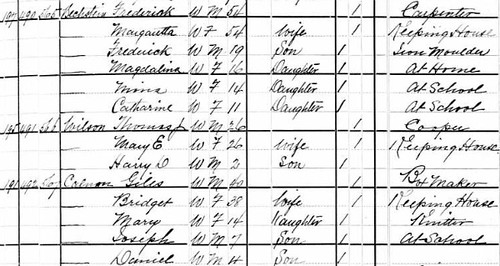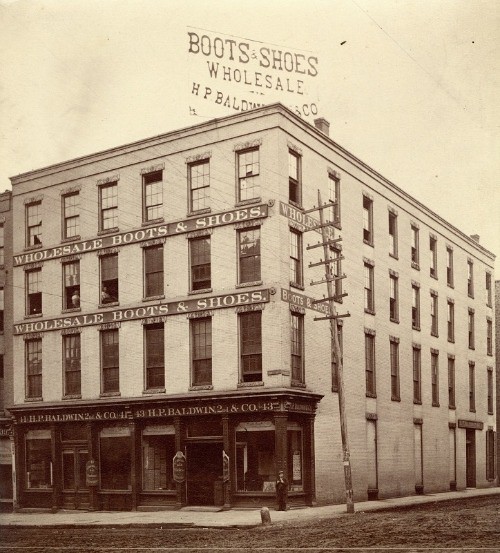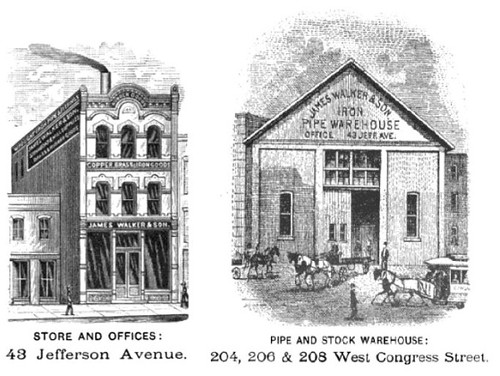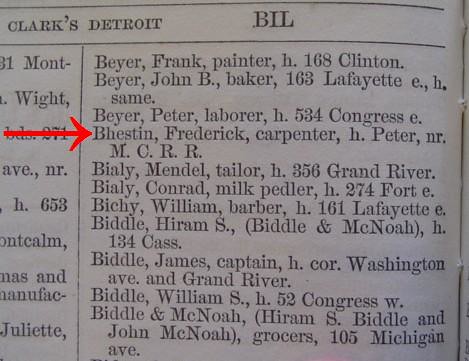William Sharkofsky
1935-1947(?)
After the Eiden family moved out of the Bechstein house, it was rented to a 49-year-old railroad engineer named William Sharkofsky. He was born on May 21, 1886 in Hamtramck, Michigan to Russian immigrants John Sharkofsky and Minnie Salmonkat Sharkofsky. He was employed by the Michigan Central Railroad around 1907. The 1910 Census noted that he worked as a fireman, which was the term once used for the engineers who controlled the fires in steam engines. He later rose to the position of conductor.

Michigan Central Rail Road yard, circa 1940. William Sharkofsky
was a conductor for MCRR when this photo was taken. (Source)
William Sharkofsky and his second wife, Lillian Persian Ruggles Sharkofsky, lived in the Bechstein house from 1935 until at least 1941, when both of their names were still listed in the city directory. They moved out at some point before the Eidens sold the house in 1948. It’s not known whether they or other renters lived there from 1942 to 1947 because city directories were not printed during World War II.
Sharkofsky retired from the railroad in 1952, having served for over forty-five years.* He died the following year, on May 19, 1953, at the age of 56. Lillian passed away October 22, 1958 at 62. They had no children.
_________________________________________________________
* New York Central System. "Monthly Roll Shows Recent NYC Retirements." Headlight 13.8 (1952): 15. Web. 6 Jan 2011.
Arthur Woodham
1948-1982
Siblings Willard and Elizabeth Eiden sold the Bechstein house to Arthur Levern Woodham on March 24, 1948. Mr. Woodham was born in Ontario Township, New York on June 26, 1899 to Edward J. Woodham and Ella Izora House Woodham. As a young man he worked as a tool maker and a shoe maker.
It’s not known at what point prior to buying the house Woodham came to Detroit. The 1956 directory indicates that he lived at 1733 Wabash with his wife, Rose Marie, and brother, Lewis Elmer Woodham. It was also noted that Arthur worked at Timken Axle, a factory located on Clark Street south of Fort Street.
In May of 1953, Arthur Woodham used the Bechstein house as collateral for a court appearance bond for Joe Valdez Gonzales. Gonzales was charged with failing to submit to induction into the armed forces. He became a Jehovah’s Witness close to the time he registered for the draft and fought to be classified as a conscientious objector on religious grounds. The local draft board, however, classified him as available for military service. He was ordered to appear for induction in February of 1953. He showed up at the designated location but refused to be inducted and was then arrested. His defense team included attorney Hayden C. Covington, himself a Jehovah’s Witness who successfully defended many of his fellow adherents against draft evasion charges. (Later in life Covington would defend boxer Muhammad Ali against similar charges.) Gonzales was found guilty as charged in a federal district court in Detroit on September 22, 1953*. He appealed the case but lost in 1954**. Covington finally argued the case before the Supreme Court of the United States in 1955 and won***.
The 1958 Detroit city directory listed Rose Marie Woodham as the operator of Woodham’s Gift Shop at 1955 Bagley. It would have been on the south side of the road, between 12th Street and Vermont. This information was presumably collected for the directory in the previous year, as the couple divorced in late 1957. The next available directory (1964) indicated that Arthur had retired. There is no listing for Woodham’s Gift Shop in that volume.

Aerial view of 1700 block of Wabash Street in 1968.
The red X marks the roof of the Bechstein house.
Courtesy of the Burton Historical Collection, Detroit Public Library
Rose Marie Woodham, who kept her ex-husband’s name and still lived in southwest Detroit, passed away on March 20, 1974 at the age of 65. Arthur’s brother Lewis passed away on June 18 of the same year at the age of 88. He still lived in the Bechstein house at the time of his death.

This photograph of the Bechstien house was taken in 1976 as part
of the Detroit/Urban Conservation Project. The home to the right,
also lived in by the Bechstein family, was demolished in 1977.
Arthur Woodham sold the house to Juan Jose and Delia C. Benavides for $1,400 on April 16, 1982. Just six days later, on April 22, Arthur died of cardiac arrhythmia. He was 82. On May 5 he was buried in Woodmere Cemetery, in the Ferndale section, block 30, space 40. His grave has no marker.
_________________________________________________________
*United States v. Gonzales, 120 F. Supp. 730 (U.S.D.C. E.D. Mich.)
**Gonzales v. United States, 212 F. 2d 71 (6th Cir.)
***Gonzales v. United States, 348 U.S. 407 (1955)
Juan Jose & Delia C. Benavides
1982-1985
Mr. and Mrs. Benavides were a young couple who rented out the Bechstein home for the brief time they owned it. They still live in southwest Detroit, but they did not reply to a letter seeking information.
Steven C. Flum
1985-2004
Corktown residents fought successfully to save their neighborhood from total destruction in the name of urban renewal in the 1950s and 1960s. In the late 1970s and 1980s, the area started to gain wider appreciation for its architectural and historic value. The segment of the neighborhood between Sixth Street and Rosa Parks Boulevard was designated a historic district on the National Register of Historic Places on July 31, 1978. There followed a wave of home rehabilitations by both longtime residents and newcomers attracted to the unique character of the neighborhood.
In 1985, one Corktown newcomer interested in historic preservation was 24-year-old Steven C. Flum, who had obtained his bachelor’s degree in architecture from Lawrence Technological University in Southfield, Michigan the previous year. On July 12, 1985, he purchased the Bechstein house from Juan Jose and Delia Benavides for $2,800. The home was in serious need of renovation. The roof, plumbing, heating, and electrical system all needed replacement. There were cosmetic problems as well--artificial wood paneling covered the walls and a drop ceiling had been installed. The brick chimney was beyond repair and had to be demolished. Flum spent the next several years bringing to house up to code.

The Bechstein house as it appeared in 1985.
Photo courtesy of Steven C. Flum

Looking into a bedroom from what was the kitchen in the original 1864 cottage.
Photo courtesy of Steven C. Flum
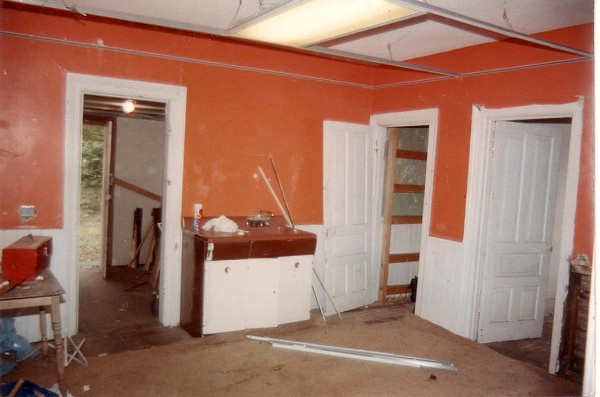
View inside "new" kitchen in the 1897 addition looking toward the back door.
Click here to see the same room as it appears today.
Photo courtesy of Steven C. Flum
In 1987, Flum purchased the vacant lot to the north, at 1739 Wabash. This was the other half of the original lot first purchased by Frederick Bechstein and sold by his heirs in 1904. Consuelo Villa and her daughters Ella and Irene sold the lot to Flum for $1,000 on November 21, 1987. Both halves of the lot were united under a single owner for the first time in almost 100 years.
Flum built a garage behind the house in the late 1980s that matches the roofline of the house. Measuring 18’ by 22’, it is only six feet shorter than the original cottage. A driveway was constructed on the former site of 1739 Wabash as the alley was impassable at the time.

Construction of the garage, circa 1988.
Photo courtesy of Steven C. Flum
The Bechstein house was featured on the second annual Historic Corktown Homes Tour on May 15, 1988.

The Bechstein house, lovingly restored, on the 1988 Historic Corktown Homes Tour.
Photo courtesy of Steven C. Flum

Photo courtesy of Steven C. Flum
Flum lived in the Bechstein house for nearly twenty years. In that time, he started his own architecture firm and designed several single- and multiple-family homes for Corktown with sensitivity to their architectural context. Examples include Homes at St. Anne (e.g., 1759 Wabash); Corktown Townhouses I, on the corner of Labrosse and Broolyn Streets, and Corktown Townhouses II, on Bagley between Brooklyn and 8th Streets, where he now resides. Flum has received many awards and recognitions for his work, including the distinction of Young Architect of the Year in 1998 by the Michigan chapter of the American Institute of Architects.
Mary C. Greenia
2004-2006
Maria Greenia purchased the home from Steve Flum on January 21, 2004. She needed to sell it only two years later, and I purchased it on July 25, 2006. There will be more about her in a future post.
Paul Szewczyk
2006-Present
I have made some improvements to the house since I bought it, but it is now apparent that the house needs a full renovation. The house is leaning backwards slightly, and the floor is warped and uneven. One of the beams has been damaged by termites and is sistered by additional joists, but this and many other repairs made to the foundation are not permanent solutions. Some day the house will be jacked up and resettled on steel I-beams and concrete piers. Such repairs often cause plaster to crack severely or fall off all together. It may be best to gut the house completely, but preserve the molding, interior doors, and other valuable details. The house has stood for nearly 150 years so far, and there is no reason it can't stand for 150 more if properly repaired.





